Surveying Erowid
Results of Visitor Surveys Are In
October 2002
Citation: Erowid Fire, Erowid Earth. "Surveying Erowid: Results of Visitor Surveys Are In". Erowid Extracts. Oct 2002;3:8-9.
In May 2002 we began a series of surveys on the site, asking some basic questions about the views and opinions of our visitors. We ran three demographic surveys, each for a single 24 hour period. Two of the surveys contained a combination of two questions and the third was a single question. We were quite pleased with the response rate, receiving more than 2,280 responses to our first survey (approximately 10% of the site visitors for the day) and more than 4,000 total responses in three days.
It's important to note that these are not scientific surveys. We have no way to track those who respond, nor to verify that they replied truthfully to questions. We do limit responses to one per I.P. address, which stops individuals from answering the survey multiple times, but it's quite likely that some responses are intentionally false.
Overall, more than 36% of those responding reported that they were students visiting out of personal interest. An additional 8% were students visiting for academic reasons. It's also interesting to note that while 22 individuals identified themselves as "Law Enforcement", five of those stated that they were visiting out of personal interest and two out of concern for a friend/child.
One notable result is that the number of people identifying themselves as students was extremely consistent between the first and second surveys (45.5% versus 46.7%). Erowid.org/extracts/v2/survey1.shtml
The survey was up for about two weeks and received around 950 total responses. Of these, 100 were deemed invalid because too little of the survey was filled out or the answers were obviously false.
The demographics of the respondents were about what we expected, with around 63% reporting they were age 13-21, 35% ages 22-35 and the rest over 35. As we anticipated, those interested in filling out a page long survey on ecstasy were somewhat younger on average than our general readership.
A statistically significant correlation was present between lifetime use, use per individual episode, maximum used per episode, and amount used in the last six months: the greater the number of lifetime uses, the more likely the individual was to report higher typical dosages, higher maximum dosages, and more frequent use in the previous six months. Heavy lifetime users were more likely to still be current users. One obvious reason for this correlation is that people who had already ceased their use of ecstasy are less likely to be visiting the Erowid MDMA Vault.
When asked about the purity of the ecstasy they have purchased, 31.4% of respondents stated they were "usually certain" that their ecstasy was pure, while 22.8% were "never certain" that the ecstasy they took was pure (see below). Interestingly, there was no statistically significant correlation between lifetime usage and perceived purity of the substance.
Respondents were asked to rank the relative risks of 12 different substances as well as select for each substance the "absolute" risk. In the relative rankings, heroin was rated the most dangerous by nearly half of those who responded while over-the-counter pain medications (aspirin, ibuprofen, etc.) were rated the least dangerous. Ecstasy and LSD were rated substantially less dangerous than heroin, cocaine, amphetamine, and PMA and slightly less dangerous than GHB, DXM, alcohol and cigarettes. When asked about absolute risks, 72.8% of respondents said they thought ecstasy use posed "some risk" or greater. About 21% said that ecstasy was "mostly safe" and only 4% said ecstasy was "very safe".
The last question asked people to rank the relative credibility of 11 different information sources. Not surprisingly, Erowid and DanceSafe were ranked well above the rest, with "public school teachers" and "police" solidly at the bottom of the credibility rankings.
There are a few other points of interest in the results; if you'd like to read more, the full results can be found at:
Erowid.org/extracts/v2/survey_ecstasy1.shtml
It's important to note that these are not scientific surveys. We have no way to track those who respond, nor to verify that they replied truthfully to questions. We do limit responses to one per I.P. address, which stops individuals from answering the survey multiple times, but it's quite likely that some responses are intentionally false.
1) Occupation & Reason for Visit
Our first survey contained a combination of two questions. The first asked which of the listed occupations best described each visitor and the second asked which category best described the reason for their visit to Erowid that day: personal interest, academic interest, professional interest, or concern for a child/friend.Overall, more than 36% of those responding reported that they were students visiting out of personal interest. An additional 8% were students visiting for academic reasons. It's also interesting to note that while 22 individuals identified themselves as "Law Enforcement", five of those stated that they were visiting out of personal interest and two out of concern for a friend/child.
2) Frequency of Erowid Visits
Our second survey asked how often each respondent visited the site. The results show that about half of our visitors are regulars (visit "daily" or "regularly"), about a quarter are infrequent visitors and 20% are first time visitors. This is consistent with past analysis of our log files which show that on any given day, about 50% of our viewers are people who have visited the site within the past month.3) Employment Status & Age
Our third survey asked additional questions about the employment status and age of our visitors: 45% responded that they were students and 35% are between the ages of 18 and 22.One notable result is that the number of people identifying themselves as students was extremely consistent between the first and second surveys (45.5% versus 46.7%). Erowid.org/extracts/v2/survey1.shtml
| Reason for Visit | Occupation |
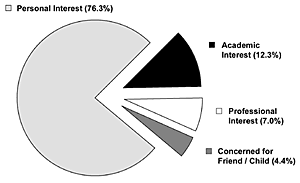 |
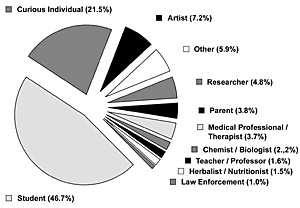 |
| Frequency of Erowid Visits | |
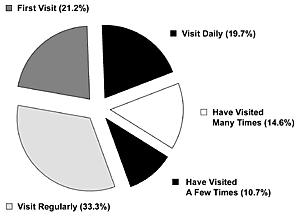 | |
| Age | Employment Status |
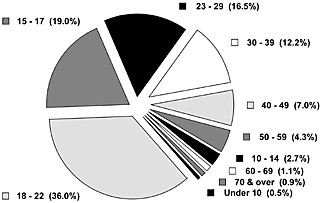 |
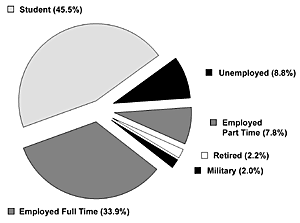 |
4) Ecstasy & Perception of Risk
In response to yet another error-ridden journal article published this summer, which repeated the unfounded assertion that ecstasy users "think ecstasy is safe", British researcher Harry Sumnall and Earth Erowid came up with a preliminary web-based survey to see how Erowid visitors would report their perception of the safety of ecstasy use.The survey was up for about two weeks and received around 950 total responses. Of these, 100 were deemed invalid because too little of the survey was filled out or the answers were obviously false.
The demographics of the respondents were about what we expected, with around 63% reporting they were age 13-21, 35% ages 22-35 and the rest over 35. As we anticipated, those interested in filling out a page long survey on ecstasy were somewhat younger on average than our general readership.
A statistically significant correlation was present between lifetime use, use per individual episode, maximum used per episode, and amount used in the last six months: the greater the number of lifetime uses, the more likely the individual was to report higher typical dosages, higher maximum dosages, and more frequent use in the previous six months. Heavy lifetime users were more likely to still be current users. One obvious reason for this correlation is that people who had already ceased their use of ecstasy are less likely to be visiting the Erowid MDMA Vault.
When asked about the purity of the ecstasy they have purchased, 31.4% of respondents stated they were "usually certain" that their ecstasy was pure, while 22.8% were "never certain" that the ecstasy they took was pure (see below). Interestingly, there was no statistically significant correlation between lifetime usage and perceived purity of the substance.
Respondents were asked to rank the relative risks of 12 different substances as well as select for each substance the "absolute" risk. In the relative rankings, heroin was rated the most dangerous by nearly half of those who responded while over-the-counter pain medications (aspirin, ibuprofen, etc.) were rated the least dangerous. Ecstasy and LSD were rated substantially less dangerous than heroin, cocaine, amphetamine, and PMA and slightly less dangerous than GHB, DXM, alcohol and cigarettes. When asked about absolute risks, 72.8% of respondents said they thought ecstasy use posed "some risk" or greater. About 21% said that ecstasy was "mostly safe" and only 4% said ecstasy was "very safe".
The last question asked people to rank the relative credibility of 11 different information sources. Not surprisingly, Erowid and DanceSafe were ranked well above the rest, with "public school teachers" and "police" solidly at the bottom of the credibility rankings.
There are a few other points of interest in the results; if you'd like to read more, the full results can be found at:
Erowid.org/extracts/v2/survey_ecstasy1.shtml
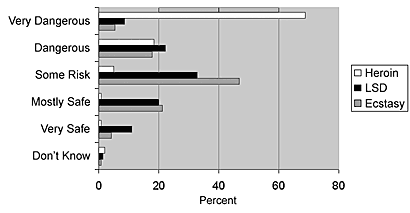 |
 |


